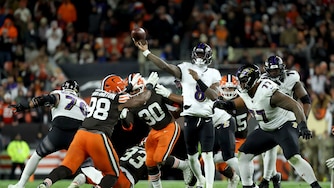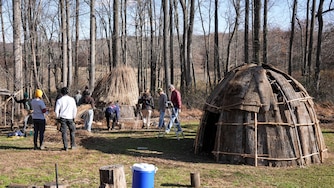For all their player development success under Mike Elias, the Orioles haven’t had to do too much hand-wringing this time of year when it comes to deciding which prospects they want to protect from the Rule 5 draft.
Teams have until 6 p.m. Tuesday to add players who signed as teenagers in 2021 or earlier, or as college players in 2022 or earlier, or else risk losing them to a team willing to take them and give them a major league roster spot next month.
This time next year, we could be talking about a significant roster crunch with the number of high-caliber pitchers and hitting prospects eligible in 2026 (unless the Orioles trade some of them). Now, however, the names you’ll probably hear bandied about — whether they’re added or left unprotected — are pretty illustrative of the state of the team’s farm system.
There’s still plenty of good. The top of the system features some impressive hitters in the low minors, and the 2023 draft class has more than a full rotation’s worth of potential major league arms, to say nothing of the results of their burgeoning international program. None of that matters where this particular deadline is concerned.
With Samuel Basallo and Dylan Beavers’ additions handled in-season when they debuted, and trade acquisition Anthony Nunez added before he could become a minor league free agent earlier this last month, the candidates remaining are a combination of players whose progress to the majors has seemingly sputtered out, who are developing more deliberately and who have had to overcome a ton of injuries.
It’s not the worst thing in the world to not have a ton of candidates to add to the roster, especially considering the success of some of the 2021 and 2022 draftees who are already in the majors. This group, however, feels like it arrived here under unique circumstances.
Outfielder Jud Fabian, for example, as a first-day pick in 2022 (67th overall) who was on a parallel path with Beavers for his entire career, albeit as a polar opposite of a player. Beavers was a contact-oriented hitter who controlled the strike zone and needed to tap into his power, whereas Fabian is a power-first hitter who needed to make enough contact for it to show up in a game.
His start at Triple-A Norfolk was promising; Fabian had an .810 OPS with 10 home runs and was striking out 27.8% of the time — which for him was a step in the right direction — before he fell off, eventually hitting the injured list with a wrist issue, and his season never recovered. He still plays major league-caliber outfield defense with a very good arm, but his finishing stretch may have hampered his chances significantly.
The main prospect remaining from the draft before that is catcher Creed Willems, who signed for $1 million as an eighth-round pick in 2021, thanks to his power profile, potential to catch and his off-field intangibles. He’s had a slow go of it through the minors, but improved every step of the way, and spent all of 2025 at Double-A Chesapeake, where he had a .779 OPS and 16 home runs while continuing to cut down on his whiffs and strikeouts.
He’s done a lot of work behind the plate as well as at it, and the fact that he’s even in the conversation is a testament to how much he’s improved from early in his career. His candidacy is typical of the Rule 5 process as a whole; the Orioles would need to weigh how worth he will be to have on their 40-man roster, given he probably won’t be ready to contribute in 2026, as well as whether another club would take and keep him.
Ultimately, they have to decide whether they’re OK potentially losing him when he’s still the unfinished product and they have more pressing long-term needs for their roster than a bat-first, left-handed hitting catcher.
There’s another million-dollar signee who has to be on the radar, too: 2020 fifth-rounder Carter Baumler, who signed for $1.5 million, had Tommy John elbow reconstruction surgery that fall, and then shoulder surgery upon his return. He’d made 21 minor league appearances before this year, but between High-A Aberdeen and Chesapeake struck out 10.7 batters per nine with a 1.00 WHIP while sitting comfortably in the mid-to-high 90s (reaching 98 mph) and missing bats with the same impressive secondary shapes he’s always had.
The Orioles are in need of near-term bullpen help, and probably won’t be structurally deficient on that front for long. Based solely on the pitcher I saw this year, though, I’d think very hard about adding Baumler. The only drawback is that carrying a reliever on a full 40-man roster who both developmentally and possibly physically may not be ready to pitch in in Baltimore is a risk. The same goes for a team that takes him, too, which means the Orioles could roll the dice.
Reed Trimble, a first-day outfielder from the 2021 draft, is in a similar boat as Baumler, in that the talent is evident when he’s on the field — he takes good at-bats, hits the ball hard, and runs well — but injuries meant we didn’t see much of him before this year.
Otherwise, the Orioles probably spent their roster meetings in the lead-up to this week talking about a bunch of pitchers, both those they drafted and developed well and those they traded for this year.
Nunez came from the Mets in the Cedric Mullins deal, and two other Mets acquisitions — Raimon Gomez and Cameron Foster —are eligible as well. Gomez’s velocity could make him a candidate but the control and results are off-putting; in both cases, it could be odd to lose someone you just acquired, even if none were the primary draw in their respective deals.
Similarly, it’s odd to think about another year where the Orioles don’t have any pitchers they drafted added to the roster, but if they do, it’ll probably be right-hander Cameron Weston, who pitched all year at Norfolk with a 4.59 ERA and 1.49 WHIP as his walk rate jumped up at the level. He doesn’t have the stuff that teams typically target in the Rule 5, but he’d be tough to lose given how close the majors he is.
The team’s top signed pitcher that year, Trace Bright, feels stuck in Double-A and hasn’t shown the stuff he did early in his career — joining other pitchers who were once at the vanguard of the pitching program, like Ryan Long, Alex Pham, and Justin Armbruester as players likely to be left off the roster this time of year.
There’s absolutely no quibbling with how the Orioles have gotten their talent to the big leagues, and they’ve also traded a fair bit of it to help supplement the major league team in the last few years. But to the extent having a bunch of high-level prospects to decide the fate of this time of year can make the Rule 5 process fun, this certainly isn’t one of those falls for the Orioles.





Comments
Welcome to The Banner's subscriber-only commenting community. Please review our community guidelines.